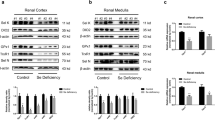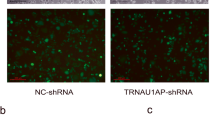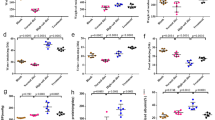Abstract
Effects of selenoproteins on many renal diseases have been reported. However, their role in renal ischemia–reperfusion (I/R) injury is unclear. The present study was performed to investigate the impact of ebselen and renal I/R injury on the expression of selenoproteins. Sprague–Dawley rats were pretreated with or without ebselen (10 mg/kg) through a daily single oral administration from 3 days before renal I/R surgery. RT-qPCR (real-time quantitative PCR) was performed to determine the mRNA expression of 25 selenoprotein genes in the renal tissues. The expression levels of two selenoproteins, including GPX3 (glutathione peroxidase 3) and DIO1 (iodothyronine deiodinase 1), were evaluated by Western blot or/and IHF (immunohistofluorescence) assays. Furthermore, renal function, renal damage, oxidative stress, and apoptosis were assessed. The results showed that in renal I/R injury, the mRNA levels of 15 selenoprotein genes (GPX1, GPX3, GPX4, DIO1, DIO2, TXNRD2, TXNRD3, SEPHS2, MSRB1, SELENOF, SELENOK, SELENOO, SELENOP, SELENOS, and SELENOT) were decreased, whereas those of eight selenoprotein genes (GPX2, GPX6, DIO3, TXNRD1, SELENOH, SELENOM, SELENOV, and SELENOW) were increased. I/R also induced a reduction in the expression levels of GPX3 and DIO1 proteins. In addition, our results indicated that ebselen reversed the changes in those selenoprotein genes, excluding SELENOH, SELENOM, SELENOP, and SELENOT, in renal I/R injury and alleviated I/R-induced renal dysfunction, tissue damage, oxidative stress, and apoptosis. To our knowledge, this is the first study to investigate the changes of 25 mammalian selenoprotein genes in renal I/R injury kidneys. The present study also provided more evidence for the roles of ebselen against renal I/R injury.







Similar content being viewed by others
Data Availability
The data used to support the findings of this study are included in the article.
References
Smith SF, Hosgood SA, Nicholson ML (2019) Ischemia-reperfusion injury in renal transplantation: 3 key signaling pathways in tubular epithelial cells. Kidney Int 95:50–56. https://doi.org/10.1016/j.kint.2018.10.009
Zuk A, Bonventre JV (2016) Acute kidney injury. Annu Rev Med 67:293–307. https://doi.org/10.1146/annurev-med-050214-013407
Wu Y, Shi H, Xu Y, Pei J, Song S, Chen W, Xu S (2022) Ebselen ameliorates renal ischemia-reperfusion injury via enhancing autophagy in rats. Mol Cell Biochem 477:1873–1885. https://doi.org/10.1007/s11010-022-04413-4
Brigelius-Flohé R, Arnér ESJ (2018) Selenium and selenoproteins in (redox) signaling, diseases, and animal models - 200 year anniversary issue. Free Radic Biol Med 127:1–2. https://doi.org/10.1016/j.freeradbiomed.2018.09.026
Zhang JL, Xu B, Huang XD, Gao YH, Chen Y, Shan AS (2016) Selenium deficiency affects the mRNA expression of inflammatory factors and selenoprotein genes in the kidneys of broiler chicks. Biol Trace Elem Res 171:201–207. https://doi.org/10.1007/s12011-015-0512-3
Iglesias P, Selgas R, Romero S, Díez JJ (2013) Selenium and kidney disease. J Nephrol 26:266–272. https://doi.org/10.5301/jn.5000213
Kizilgun M, Poyrazoglu Y, Oztas Y, Yaman H, Cakir E, Cayci T, Akgul OE, Kurt YG, Yaren H, Kunak ZI, Macit E, Ozkan E, Taslipinar MY, Turker T, Ozcan A (2011) Beneficial effects of N-acetylcysteine and ebselen on renal ischemia/reperfusion injury. Ren Fail 33:512–517. https://doi.org/10.3109/0886022x.2011.574767
Namura S, Nagata I, Takami S, Masayasu H, Kikuchi H (2001) Ebselen reduces cytochrome c release from mitochondria and subsequent DNA fragmentation after transient focal cerebral ischemia in mice. Stroke 32:1906–1911. https://doi.org/10.1161/01.str.32.8.1906
Ozturk H, Cetinkaya A, Duzcu SE, Tekce BK, Ozturk H (2018) Carvacrol attenuates histopathogic and functional impairments induced by bilateral renal ischemia/reperfusion in rats. Biomed Pharmacother 98:656–661. https://doi.org/10.1016/j.biopha.2017.12.060
Livak KJ, Schmittgen TD (2001) Analysis of relative gene expression data using real-time quantitative PCR and the 2(-delta delta C(T)) method. Methods 25:402–408. https://doi.org/10.1006/meth.2001.1262
Long X, You G, Wu Q, Zhou Y, Xiao Y, Yu F, Deng S, Mo R, Song F, Huang J, Tian M (2021) HomeoboxC6 affects the apoptosis of human vascular endothelial cells and is involved in atherosclerosis. J Cell Physiol 236:1913–1925. https://doi.org/10.1002/jcp.29974
Paller MS, Hoidal JR, Ferris TF (1984) Oxygen free radicals in ischemic acute renal failure in the rat. J Clin Invest 74:1156–1164. https://doi.org/10.1172/jci111524
Gornall AG, Bardawill CJ, David MM (1949) Determination of serum proteins by means of the biuret reaction. J Biol Chem 177:751–766
Kar F, Hacioglu C, Senturk H, Donmez DB, Kanbak G (2020) The role of oxidative stress, renal inflammation, and apoptosis in post ischemic reperfusion injury of kidney tissue: the protective effect of dose-dependent boric acid administration. Biol Trace Elem Res 195:150–158. https://doi.org/10.1007/s12011-019-01824-1
Ding M, Tolbert E, Birkenbach M, Gohh R, Akhlaghi F, Ghonem NS (2021) Treprostinil reduces mitochondrial injury during rat renal ischemia-reperfusion injury. Biomed Pharmacother 141:111912. https://doi.org/10.1016/j.biopha.2021.111912
Prem PN, Kurian GA (2021) High-fat diet increased oxidative stress and mitochondrial dysfunction induced by renal ischemia-reperfusion injury in rat. Front Physiol 12:715693. https://doi.org/10.3389/fphys.2021.715693
Can B, Kar F, Kar E, Özkoç M, Şentürk H, Dönmez DB, Kanbak G, Alataş İ (2021) Conivaptan and boric acid treatments in acute kidney injury: is this combination effective and safe? Biol Trace Elem Res. https://doi.org/10.1007/s12011-021-02977-8
Mar D, Gharib SA, Zager RA, Johnson A, Denisenko O, Bomsztyk K (2015) Heterogeneity of epigenetic changes at ischemia/reperfusion- and endotoxin-induced acute kidney injury genes. Kidney Int 88:734–744. https://doi.org/10.1038/ki.2015.164
Wen Y, Parikh CR (2021) Current concepts and advances in biomarkers of acute kidney injury. Crit Rev Clin Lab Sci 58:354–368. https://doi.org/10.1080/10408363.2021.1879000
Sohotnik R, Nativ O, Abbasi A, Awad H, Frajewicki V, Bishara B, Sukhotnik I, Armaly Z, Aronson D, Heyman SN, Nativ O, Abassi Z (2013) Phosphodiesterase-5 inhibition attenuates early renal ischemia-reperfusion-induced acute kidney injury: assessment by quantitative measurement of urinary NGAL and KIM-1. Am J Physiol Renal Physiol 304:F1099–F1104. https://doi.org/10.1152/ajprenal.00649.2012
Xie Y, Xiao J, Fu C, Zhang Z, Ye Z, Zhang X (2018) Ischemic preconditioning promotes autophagy and alleviates renal ischemia/reperfusion injury. Biomed Res Int 2018:8353987. https://doi.org/10.1155/2018/8353987
Tejchman K, Kotfis K, Sieńko J (2021) Biomarkers and mechanisms of oxidative stress-last 20 years of research with an emphasis on kidney damage and renal transplantation. Int J MolSci 22 https://doi.org/10.3390/ijms22158010
Ryter SW, Kim HP, Hoetzel A, Park JW, Nakahira K, Wang X, Choi AM (2007) Mechanisms of cell death in oxidative stress. Antioxid Redox Signal 9:49–89. https://doi.org/10.1089/ars.2007.9.49
Zheng JH, Viacava Follis A, Kriwacki RW, Moldoveanu T (2016) Discoveries and controversies in BCL-2 protein-mediated apoptosis. Febs j 283:2690–2700. https://doi.org/10.1111/febs.13527
Chien CT, Chang TC, Tsai CY, Shyue SK, Lai MK (2005) Adenovirus-mediated bcl-2 gene transfer inhibits renal ischemia/reperfusion induced tubular oxidative stress and apoptosis. Am J Transplant 5:1194–1203. https://doi.org/10.1111/j.1600-6143.2005.00826.x
Tang CY, Lai CC, Huang PH, Yang AH, Chiang SC, Huang PC, Tseng KW, Huang CH (2017) Magnolol reduces renal ischemia and reperfusion injury via inhibition of apoptosis. Am J Chin Med 45:1421–1439. https://doi.org/10.1142/s0192415x1750077x
Zhao X, Zhang E, Ren X, Bai X, Wang D, Bai L, Luo D, Guo Z, Wang Q, Yang J (2020) Edaravone alleviates cell apoptosis and mitochondrial injury in ischemia-reperfusion-induced kidney injury via the JAK/STAT pathway. Biol Res 53:28. https://doi.org/10.1186/s40659-020-00297-0
Shao G, He J, Meng J, Ma A, Geng X, Zhang S, Qiu Z, Lin D, Li M, Zhou H, Lin S, Yang B (2021) Ganoderic acids prevent renal ischemia reperfusion injury by inhibiting inflammation and apoptosis. Int J MolSci :22 https://doi.org/10.3390/ijms221910229
Yan B, Min SJ, Xu B, Zhang C, Pei J, Zhang W, Luo GH (2021) The protective effects of exogenous spermine on renal ischemia-reperfusion injury in rats. Transl Androl Urol 10:2051–2066. https://doi.org/10.21037/tau-21-280
Gladyshev VN, Arnér ES, Berry MJ, Brigelius-Flohé R, Bruford EA, Burk RF, Carlson BA, Castellano S, Chavatte L, Conrad M, Copeland PR, Diamond AM, Driscoll DM, Ferreiro A, Flohé L, Green FR, Guigó R, Handy DE, Hatfield DL, Hesketh J, Hoffmann PR, Holmgren A, Hondal RJ, Howard MT, Huang K, Kim HY, Kim IY, Köhrle J, Krol A, Kryukov GV, Lee BJ, Lee BC, Lei XG, Liu Q, Lescure A, Lobanov AV, Loscalzo J, Maiorino M, Mariotti M, Sandeep Prabhu K, Rayman MP, Rozovsky S, Salinas G, Schmidt EE, Schomburg L, Schweizer U, Simonović M, Sunde RA, Tsuji PA, Tweedie S, Ursini F, Whanger PD, Zhang Y (2016) Selenoprotein gene nomenclature. J Biol Chem 291:24036–24040. https://doi.org/10.1074/jbc.M116.756155
Koeberle SC, Gollowitzer A, Laoukili J, Kranenburg O, Werz O, Koeberle A, Kipp AP (2020) Distinct and overlapping functions of glutathione peroxidases 1 and 2 in limiting NF-κB-driven inflammation through redox-active mechanisms. Redox Biol 28:101388. https://doi.org/10.1016/j.redox.2019.101388
Brigelius-Flohé R, Kipp AP (2012) Physiological functions of GPx2 and its role in inflammation-triggered carcinogenesis. Ann N Y Acad Sci 1259:19–25. https://doi.org/10.1111/j.1749-6632.2012.06574.x
Shema R, Kulicke R, Cowley GS, Stein R, Root DE, Heiman M (2015) Synthetic lethal screening in the mammalian central nervous system identifies Gpx6 as a modulator of Huntington’s disease. Proc Natl Acad Sci USA 112:268–272. https://doi.org/10.1073/pnas.1417231112
Tan L, Xue X, Du J, Xie Y, Tang SF, Hou X (2020) Probing the molecular toxic mechanism of lead (II) ions with glutathione peroxidase 6 from Arabidopsis thaliana. Spectrochim Acta A Mol Biomol Spectrosc 226:117597. https://doi.org/10.1016/j.saa.2019.117597
Flamant F, Gauthier K, Richard S (2017) Genetic investigation of thyroid hormone receptor function in the developing and adult brain. Curr Top Dev Biol 125:303–335. https://doi.org/10.1016/bs.ctdb.2017.01.001
Dudek KM, Suter L, Darras VM, Marczylo EL, Gant TW (2013) Decreased translation of Dio3 mRNA is associated with drug-induced hepatotoxicity. Biochem J 453:71–82. https://doi.org/10.1042/bj20130049
Schmidt EE (2015) Interplay between cytosolic disulfide reductase systems and the Nrf2/Keap1 pathway. Biochem Soc Trans 43:632–638. https://doi.org/10.1042/bst20150021
Cebula M, Schmidt EE, Arnér ES (2015) TrxR1 as a potent regulator of the Nrf2-Keap1 response system. Antioxid Redox Signal 23:823–853. https://doi.org/10.1089/ars.2015.6378
Nezu M, Suzuki N (2020) Roles of Nrf2 in protecting the kidney from oxidative damage. Int J MolSci :21 https://doi.org/10.3390/ijms21082951
Tonelli C, Chio IIC, Tuveson DA (2018) Transcriptional regulation by Nrf2. Antioxid Redox Signal 29:1727–1745. https://doi.org/10.1089/ars.2017.7342
Bertz M, Kühn K, Koeberle SC, Müller MF, Hoelzer D, Thies K, Deubel S, Thierbach R, Kipp AP (2018) Selenoprotein H controls cell cycle progression and proliferation of human colorectal cancer cells. Free Radic Biol Med 127:98–107. https://doi.org/10.1016/j.freeradbiomed.2018.01.010
Wu RT, Cao L, Chen BP, Cheng WH (2014) Selenoprotein H suppresses cellular senescence through genome maintenance and redox regulation. J Biol Chem 289:34378–34388. https://doi.org/10.1074/jbc.M114.611970
Reeves MA, Bellinger FP, Berry MJ (2010) The neuroprotective functions of selenoprotein M and its role in cytosolic calcium regulation. Antioxid Redox Signal 12:809–818. https://doi.org/10.1089/ars.2009.2883
Gong T, Hashimoto AC, Sasuclark AR, Khadka VS, Gurary A, Pitts MW (2021) Selenoprotein M promotes hypothalamic leptin signaling and thioredoxin antioxidant activity. Antioxid Redox Signal 35:775–787. https://doi.org/10.1089/ars.2018.7594
Zhang X, Xiong W, Chen LL, Huang JQ, Lei XG (2020) Selenoprotein V protects against endoplasmic reticulum stress and oxidative injury induced by pro-oxidants. Free Radic Biol Med 160:670–679. https://doi.org/10.1016/j.freeradbiomed.2020.08.011
Chen LL, Huang JQ, Xiao Y, Wu YY, Ren FZ, Lei XG (2020) Knockout of selenoprotein V affects regulation of selenoprotein expression by dietary selenium and fat intakes in mice. J Nutr 150:483–491. https://doi.org/10.1093/jn/nxz287
Whanger PD (2000) Selenoprotein W: a review. Cell Mol Life Sci 57:1846–1852. https://doi.org/10.1007/pl00000666
Yu D, Zhang Z, Yao H, Li S, Xu SW (2015) The role of selenoprotein W in inflammatory injury in chicken immune tissues and cultured splenic lymphocyte. Biometals 28:75–87. https://doi.org/10.1007/s10534-014-9804-x
Lei XG, Cheng WH, McClung JP (2007) Metabolic regulation and function of glutathione peroxidase-1. Annu Rev Nutr 27:41–61. https://doi.org/10.1146/annurev.nutr.27.061406.093716
De Haan JB, Crack PJ, Flentjar N, Iannello RC, Hertzog PJ, Kola I (2003) An imbalance in antioxidant defense affects cellular function: the pathophysiological consequences of a reduction in antioxidant defense in the glutathione peroxidase-1 (Gpx1) knockout mouse. Redox Rep 8:69–79. https://doi.org/10.1179/135100003125001378
Chang C, Worley BL, Phaëton R, Hempel N (2020) Extracellular glutathione peroxidase GPx3 and its role in cancer. Cancers (Basel) 12 https://doi.org/10.3390/cancers12082197
Zhao L, Zong W, Zhang H, Liu R (2019) Kidney toxicity and response of selenium containing protein-glutathione peroxidase (Gpx3) to CdTe QDs on different levels. Toxicol Sci 168:201–208. https://doi.org/10.1093/toxsci/kfy297
Seibt TM, Proneth B, Conrad M (2019) Role of GPX4 in ferroptosis and its pharmacological implication. Free Radic Biol Med 133:144–152. https://doi.org/10.1016/j.freeradbiomed.2018.09.014
Friedmann Angeli JP, Schneider M, Proneth B, Tyurina YY, Tyurin VA, Hammond VJ, Herbach N, Aichler M, Walch A, Eggenhofer E, Basavarajappa D, Rådmark O, Kobayashi S, Seibt T, Beck H, Neff F, Esposito I, Wanke R, Förster H, Yefremova O, Heinrichmeyer M, Bornkamm GW, Geissler EK, Thomas SB, Stockwell BR, O’Donnell VB, Kagan VE, Schick JA, Conrad M (2014) Inactivation of the ferroptosis regulator Gpx4 triggers acute renal failure in mice. Nat Cell Biol 16:1180–1191. https://doi.org/10.1038/ncb3064
Kameritsch P, Singer M, Nuernbergk C , Rios N, Reyes AM, Schmidt K, Kirsch J, Schneider H, Müller S, Pogoda K, Cui R, Kirchner T, Wit de C, Lange-Sperandio B, Pohl U Conrad M, Radi R, Beck H (2021) The mitochondrial thioredoxin reductase system (TrxR2) in vascular endothelium controls peroxynitrite levels and tissue integrity. Proc Natl AcadSci USA :118. https://doi.org/10.1073/pnas.1921828118
Yoshioka J (2015) Thioredoxin Reductase 2 (Txnrd2) Regulates mitochondrial integrity in the progression of age-related heart failure. J Am Heart Assoc :4 https://doi.org/10.1161/jaha.115.002278
Zhang J, Li Y, Duan D, Yao J, Gao K, Fang J (2016) Inhibition of thioredoxin reductase by alantolactone prompts oxidative stress-mediated apoptosis of HeLa cells. Biochem Pharmacol 102:34–44. https://doi.org/10.1016/j.bcp.2015.12.004
Liu Q, Du P, Zhu Y, Zhang X, Cai J, Zhang Z (2022) Thioredoxin reductase 3 suppression promotes colitis and carcinogenesis via activating pyroptosis and necrosis. Cell Mol Life Sci 79:106. https://doi.org/10.1007/s00018-022-04155-y
Sabatino L, Vassalle C, Del Seppia C, Iervasi G (2021) Deiodinases and the three types of thyroid hormone deiodination reactions. Endocrinol Metab (Seoul) 36:952–964. https://doi.org/10.3803/EnM.2021.1198
Köhrle J (2007) Thyroid hormone transporters in health and disease: advances in thyroid hormone deiodination. Best Pract Res Clin Endocrinol Metab 21:173–191. https://doi.org/10.1016/j.beem.2007.04.001
Xu XM, Carlson BA, Irons R, Mix H, Zhong N, Gladyshev VN, Hatfield DL (2007) Selenophosphate synthetase 2 is essential for selenoprotein biosynthesis. Biochem J 404:115–120. https://doi.org/10.1042/bj20070165
Nunziata C, Polo A, Sorice A, Capone F, Accardo M, Guerriero E, Marino FZ, Orditura M, Budillon A, Costantini S (2019) Structural analysis of human SEPHS2 protein, a selenocysteine machinery component, over-expressed in triple negative breast cancer. Sci Rep 9:16131. https://doi.org/10.1038/s41598-019-52718-0
Tang JY, He AH, Jia G, Liu GM, Chen XL, Cai JY, Shang HY, Liao JQ, Zhao H (2018) Protective effect of selenoprotein X against oxidative stress-induced cell apoptosis in human hepatocyte (LO2) cells via the p38 pathway. Biol Trace Elem Res 181:44–53. https://doi.org/10.1007/s12011-017-1025-z
Tang J, Cao L, Li Q, Wang L, Jia G, Liu G, Chen X, Cai J, Shang H, Zhao H (2016) Selenoprotein X gene knockdown aggravated H2O2-induced apoptosis in liver LO2 cells. Biol Trace Elem Res 173:71–78. https://doi.org/10.1007/s12011-016-0653-z
Burk RF, Hill KE (2015) Regulation of selenium metabolism and transport. Annu Rev Nutr 35:109–134. https://doi.org/10.1146/annurev-nutr-071714-034250
Yan J, Fei Y, Han Y, Lu S (2016) Selenoprotein O deficiencies suppress chondrogenic differentiation of ATDC5 cells. Cell Biol Int 40:1033–1040. https://doi.org/10.1002/cbin.10644
Sreelatha A, Yee SS, Lopez VA, Park BC, Kinch LN, Pilch S, Servage KA, Zhang J, Jiou J, Karasiewicz-Urbańska M, Łobocka M, Grishin NV, Orth K, Kucharczyk R, Pawłowski K, Tomchick DR, Tagliabracci VS (2018) Protein AMPylation by an evolutionarily conserved pseudokinase. Cell 175:809-821.e19. https://doi.org/10.1016/j.cell.2018.08.046
Shchedrina VA, Zhang Y, Labunskyy VM, Hatfield DL, Gladyshev VN (2010) Structure-function relations, physiological roles, and evolution of mammalian ER-resident selenoproteins. Antioxid Redox Signal 12:839–849. https://doi.org/10.1089/ars.2009.2865
Liu L, Liu C, Hou L, Lv J, Wu F, Yang X, Ren S, Ji W, Wang M, Chen L (2015) Protection against ischemia/reperfusion-induced renal injury by co-treatment with erythropoietin and sodium selenite. Mol Med Rep 12:7933–7940. https://doi.org/10.3892/mmr.2015.4426
Ostróżka-Cieślik A, Dolińska B, Ryszka F (2020) Therapeutic potential of selenium as a component of preservation solutions for kidney transplantation. Molecules 25 https://doi.org/10.3390/molecules25163592
Funding
This study was sponsored by the National Natural Science Foundation of China (82160145), the Science and Technology Fund of Guizhou Health Commission ((gzwkj2021-212) and (gzwjkj2020-1–113)), and the Guizhou Science and Technology Project (QKHZC(2021)085).
Author information
Authors and Affiliations
Contributions
Conceptualization: Yikun Wu; data acquisition: Yikun Wu and Hua Shi; methodology: Yuangao Xu, Rao Wen, and Maodi Gong; resources: Shuxiong Xu and Hua Shi; data curation: Yikun Wu and Hua Shi; writing, review, and editing: Yikun Wu, Hua Shi, Shuxiong Xu, and Guangyi Hong; visualization: Rao Wen and Maodi Gong; supervision: Shuxiong Xu and Hua Shi; project administration and funding: Shuxiong Xu and Hua Shi. The authors declare that all data were generated in-house and that no paper mill was used.
Corresponding author
Ethics declarations
Ethics Approval
The study was approved by the Ethics Committee of Guizhou Provincial People’s Hospital and was performed in compliance with the ethical standards laid down in the 1964 Declaration of Helsinki and its later amendments.
Conflict of Interest
The authors declare no competing interests.
Additional information
Publisher’s Note
Springer Nature remains neutral with regard to jurisdictional claims in published maps and institutional affiliations.
Rights and permissions
About this article
Cite this article
Wu, Y., Shi, H., Xu, Y. et al. Selenoprotein Gene mRNA Expression Evaluation During Renal Ischemia–Reperfusion Injury in Rats and Ebselen Intervention Effects. Biol Trace Elem Res 201, 1792–1805 (2023). https://doi.org/10.1007/s12011-022-03275-7
Received:
Accepted:
Published:
Issue Date:
DOI: https://doi.org/10.1007/s12011-022-03275-7




